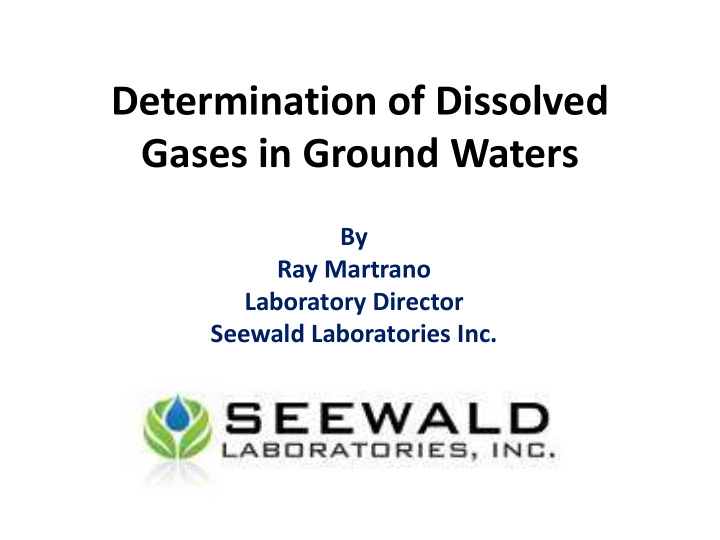



Determination of Dissolved Gases in Ground Waters By Ray Martrano Laboratory Director Seewald Laboratories Inc.
Overview of Presentation What is a dissolved gas? Why do w e w ant to study dissolved gases? Methods used for dissolved gases Limitations Thoughts for the future
What is a Dissolved Gas? Any Gas that can be found in solution Has significant vapor pressure at room temperature Difference betw een gases and liquids are functions of temperature and pressure
VOCs and Dissolved Gases VOCs are dissolved gases Most commonly identified as volatile liquids Elemental gases and low MW compounds Permanent gases Many methods are available for VOCs Many methods for gases
Reasons for Studying Dissolved Gases Dissolved Oxygen, BOD Energy related issues Identification of hazards Bioremediation Marcellus Shale
What is Marcellus Shale One of the largest natural gas formations recently found. Enough energy to supply U.S. for several years Methane is recovered by hydraulic fracking Grow ing need to monitor methane in groundw ater
House Explosions in Bradford, Pennsylvania tied to Migrating Methane Gas from Drilling Activity March 24, 2011 A home in Bradford PA where apparent gas migration caused it to explode
Common methods for dissolved gases RSK 175 PA DEP Method Headspace methods ASTM Method TO-XX air methods
Background on Gas Law s Equilibrium Vapor-liquid equilibrium ( VLE ) is a condition where a liquid and its vapor (gas phase) are in equilibrium with each other, a condition or state where the rate of evaporation (liquid changing to vapor) equals the rate of condensation (vapor changing to liquid) on a molecular level such that there is no net (overall) vapor-liquid interconversion.
Ideal Gas Law The state of an amount of gas is determined by its pressure, volume, and temperature. The modern form of the equation is: where P is the absolute pressure of the gas; V is the volume; n is the amount of substance of gas and R is the ideal, or universal, gas constant, and T is the absolute temperature.
Dalton’s Law Dalton's law (also called Dalton's law of partial pressures ) states that the total pressure exerted by a gaseous mixture is equal to the sum of the partial pressures of each individual component in a gas mixture. where represent the partial pressure of each component. It is assumed that the gases do not react with each other. Where: the mole fraction of the i-th component in the total mixture of n components
Raoult’s Law Raoult’s Law: the vapor pressure of an ideal solution is dependent on the vapor pressure of each chemical component and the mole fraction of the component present in the solution . Once the components in the solution have reached equilibrium, the total vapor pressure p of the solution is: and the individual vapor pressure for each component: p i is the partial pressure of the component i in the mixture (in the solution) p * i is the vapor pressure of the pure component i x i is the mole fraction of the component i in the mixture (in the solution)
Henry’s Law With a little work for ideal systems: pi = pi* xi = P total yi For real systems we have Henry’s Law At a constant temperature, the amount of a given gas that dissolves in a given type and volume of liquid is directly proportional to the partial pressure of that gas in equilibrium with that liquid. Pi = xi Hi Hi = Henry’s law constant for i th component
RSK 175 Founded on Henry’s Law Developed at EPA’s Robert S. Kerr Laboratory Standard Operating Procedure 175
RSK 175 Procedure GC/FID; Calibrated by injecting gas standards Collected in headspace free containers Headspace generated in laboratory Concentration of headspace determined Concentration of liquid is calculated
RSK 175 Advantages Gives good approximation of liquid concentrations Accounts for vapor and liquid Easy, quick chromatographic method Can be used for other applications
RSK 175 Disadvantages Manual method Standards are expensive Limited QA procedures Dilutions done manually
PA DEP Method Described as an in-house method Uses headspace sampling device Calibration done on saturated solutions and subsequent dilutions Pure response factor method Does not use Henry’s Law
PA DEP Method Advantages Automated No complex calculations Reduced standard cost (for methane) Quick GC/FID method
PA DEP Method Disadvantages Handling of standards Limited application Multi component analysis complicated Diluting samples
The Future Field Sampling Containers Preservation Holding times Standardization of methods No formal method Lack of certification Lack of know ledge Lack of maximum contaminant levels (MCLs) Lack of certified reference materials, PE samples
THANK YOU Ray Martrano Laboratory Director Seewald Laboratories Inc. 2829 Reach Road Williamsport Pa 17701 570-326-4001 rmartrano@seewaldlabs.com www.seewaldlabs.com
Recommend
More recommend